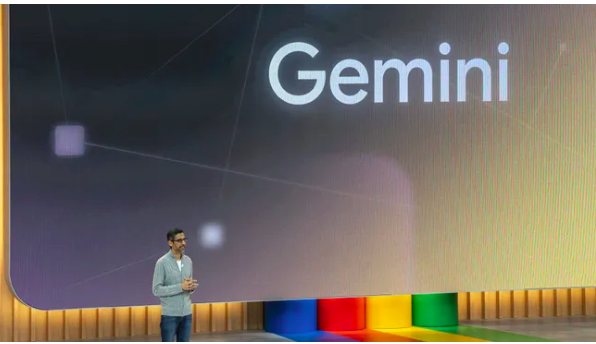Best Robot You Can Buy: Robosen’s Megatron Auto-Transforms via Voice Commands
Robosen and Hasbro have collaborated to launch Robosen’s first villainous Transformers robot: Megatron. This robot meets every expectation a fan could have, seamlessly transforming from a bipedal robot to a rolling tank using voice commands.

It features a cannon that shoots plastic darts and responds to touch with sensitive panels located on its front and back. With 22 lights and 36 servo motors, Megatron vividly animates its limbs in sync with menacing dialogues voiced by Frank Welker, the original voice of Megatron from the 1984 cartoon series. Priced at $899, it’s currently available for preorder and is expected to be released later this year.
This product is not just a simple toy for kids. The robot offers more animations and phrases which can be unlocked using its app, though I haven’t tested this feature yet. I will provide an update to this post once I have.
Google has updated Chrome’s address bar with a new shortcut that simplifies the process of interacting with its AI chatbot, Gemini.
Google’s latest AI model, Gemini, is being incorporated into various existing Google products, with a notable enhancement to Chrome’s address bar. Soon, users will be able to initiate conversations with Gemini by typing the shortcut ‘@gemini’ directly into the address bar.

Known as the ‘omnibox,’ Google’s address bar serves multiple functions and already supports shortcuts like ‘@bookmarks’ and ‘@history.’ By entering ‘@gemini’ followed by a query, users can quickly engage with the AI chatbot. This feature is gradually being rolled out, so while some users may already have access, others can expect to see it enabled very soon.
This enhancement comes soon after Chrome’s address bar received a significant upgrade with Google AI technology, aimed at improving its recommendation system to better suit individual user preferences over time. Together with the new ‘@gemini’ shortcut, these developments are likely to notably enhance your overall browsing experience, making it more intuitive and responsive to your needs.
Amazon is broadening its enterprise AI strategy by making its Q chatbot more widely available.
Amazon is intensifying its focus on enterprise AI with the expansion of its AI chatbot, Q, initially launched in November to a limited audience. According to Amazon CEO Andy Jassy, the broader release of Q aims to address alignment issues for developers. The chatbot serves as an assistant within Amazon Web Services (AWS), allowing employees to leverage their company’s data and workflows to ask business-related questions. Q can also assist with inquiries about coding, HR, and logistics.

Amazon’s AI strategy predominantly targets business solutions under the AWS umbrella. The company also manages Amazon Bedrock, a model library that provides businesses access to Amazon’s extensive language models and other prominent open-source AI models such as Llama 3, Claude 3, and Stable Diffusion. The uses of Amazon Q are primarily oriented towards enhancing developer and business operations.
Amazon has enhanced its AI chatbot Q with new features ahead of its general availability. The introduction of Amazon Q Developer is set to transform the workflow for developers by offering coding assistance, application testing, security scanning, and troubleshooting capabilities. Developers can utilize Q to list their AWS resources, assess computing power, or even deploy AI agents that autonomously handle tasks such as software updates or code documentation.
Additionally, Amazon has launched Amazon Q Apps, a feature designed to simplify the creation of generative AI-based applications. This tool is particularly user-friendly for those without coding skills; users need only describe the type of application they want in a prompt, and Q will generate the desired app. This expansion in capabilities underscores Amazon’s commitment to making AI tools more accessible and functional within the enterprise sector.
A covert Swiss lab might be the driving force behind all of Apple’s upcoming products.
The “Zurich Vision Lab” in Switzerland is rumored to be a central hub for Apple’s extensive research efforts, impacting major projects like the Apple Car, an AR Headset, and advancements in Siri. Initially exposed in 2017 as a research site, the facility was linked to Apple’s automotive endeavors. Current findings now suggest that this lab plays a pivotal role in a variety of Apple’s long-term projects, particularly in artificial intelligence.

While Apple typically showcases its international research centers, it remains secretive about operations that could disclose insights into future product strategies. For example, AppleInsider has previously reported on a concealed facility in Sunnyvale, California, similar to the secretive operations in Berlin known to be focused on automotive research. These secretive labs indicate Apple’s strategic efforts to innovate and develop new technologies across multiple domains.
Microsoft has announced a significant investment of $1.7 billion to support and advance Indonesia’s cloud computing and artificial intelligence ambitions.
Microsoft has committed to investing $1.7 billion over the next four years to enhance cloud and AI infrastructure in Indonesia, alongside initiatives to provide AI training for 840,000 individuals and bolster the nation’s burgeoning developer community. This investment marks the largest in Microsoft’s 29-year history in Indonesia and aims to support the Indonesian government’s “Golden Indonesia 2045 Vision,” which seeks to transform the country into a global economic leader.

Satya Nadella, Chairman and CEO of Microsoft, highlighted the transformative impact of AI on global living and working environments, including Indonesia. He emphasized that the investments would extend across digital infrastructure, skills development, and developer support, positioning Indonesia to prosper in the emerging AI-driven era.
Budi Arie Setiadi, Indonesia’s Minister of Communications and Information Technology, underscored the strategic importance of the collaboration with Microsoft for achieving the Golden Indonesia 2045 vision, noting it aligns with Indonesia’s digital innovation goals. He expressed confidence that this partnership would enable Indonesia to contribute significantly to the global technology landscape, moving beyond merely consuming technology to becoming a key player in the technological supply chain.
Dharma Simorangkir, President Director of Microsoft Indonesia, described the investment as a milestone for Indonesia’s digital landscape, aiming to equip Indonesians with the necessary infrastructure and skills for the AI era and align with the national vision for digital excellence. This initiative is a significant step towards establishing Indonesia as a hub for digital talent and innovation.
Google has recently laid off hundreds of employees from its ‘Core’ team and has relocated some positions to India and Mexico.
Just before releasing its impressive first-quarter earnings report on April 25, Google implemented significant changes by laying off at least 200 employees from its “Core” teams. This restructuring effort includes relocating some roles to India and Mexico, as reported by CNBC. The Core unit is pivotal in developing the technical backbone for Google’s key products and maintaining online safety for users. This division encompasses essential technical groups such as information technology, Python developers, technical infrastructure, security foundation, app platforms, core developers, and various engineering positions.

Notably, at least 50 engineering positions at Google’s Sunnyvale, California offices were affected, according to official filings. The plan includes hiring for corresponding roles in Mexico and India, reflecting a shift in the company’s operational focus. Asim Husain, vice president of Google Developer Ecosystem, communicated the layoffs through an email to his team and addressed the changes in a town hall meeting, describing this move as the largest planned reduction for his team within the year, per internal documents.
Anthropic has officially launched a mobile app for Claude, its AI model.
Anthropic has released a mobile app for Claude, its AI model, now available for free to all users. The app provides a seamless experience that mirrors the web version, allowing users to access their existing chat history and continue ongoing conversations with Claude.
Additionally, the app includes image analysis features, enabling users to upload photos directly from their iPhones. This mobile functionality enhances Claude’s convenience and versatility, especially for professionals on the move. For instance, a business analyst can quickly upload a chart during a meeting and ask Claude to summarize the key points, or a salesperson can take a photo of a product during a client visit and instantly get detailed information about its features and specifications. Anthropic is also developing a version of the app for Android users.

Anthropic has expanded its offerings with the introduction of a new subscription plan called “Team” for its Claude chatbot. Priced at $30 per user per month, this plan is tailored specifically for the needs of organizations and businesses. It provides a significant enhancement over the existing Pro plan by increasing usage limits, which allows for more frequent and comprehensive interactions with Claude. This makes it possible for teams to utilize Claude’s capabilities for a broader array of tasks.
Additionally, the Team plan includes administrative tools and features for billing management, which streamline the process of onboarding new users and simplify the financial aspects for businesses. There’s also a new “context window” feature that facilitates more complex, multi-step conversations and supports the uploading of lengthy documents for in-depth analysis, enhancing the overall utility of the chatbot in professional settings.
